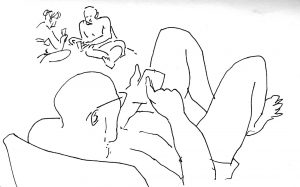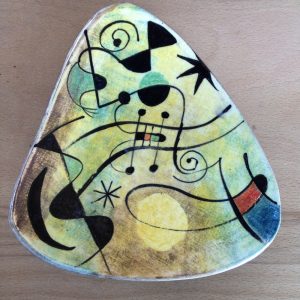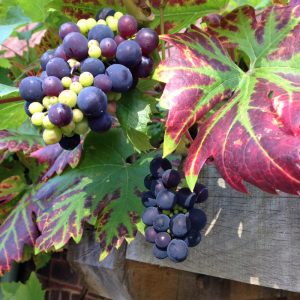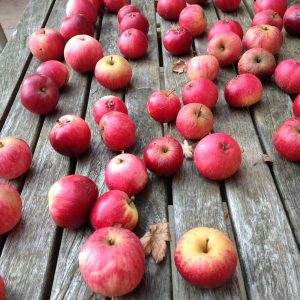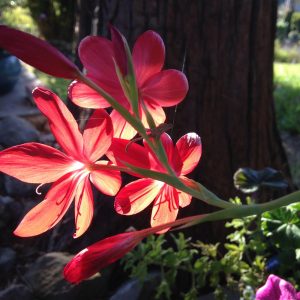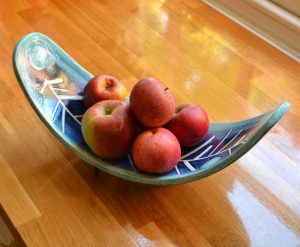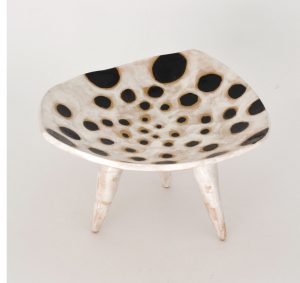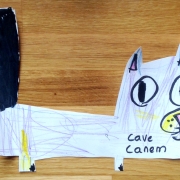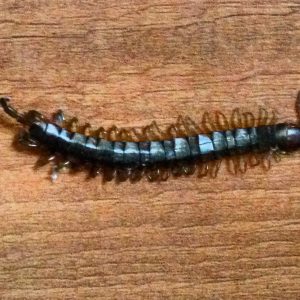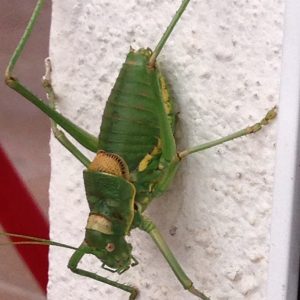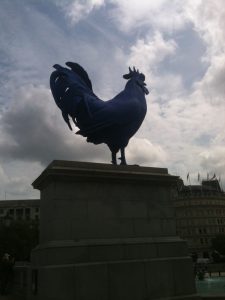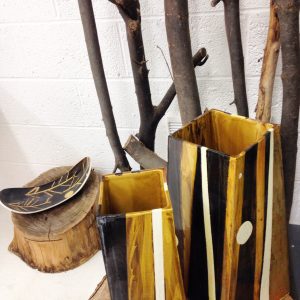My conversation with Eric
This is the time of the wild daffodils, and one of the best surviving wild daffodil meadows in the UK is the Vell Mill meadow, where thousands of people used to visit during the spring – traveling up from London on the train to pick the flowers to take back and sell. They’d load them on the train known as the Daffodil Express.
It is an easy and unchallenging walk along the Poets Path – a reminder of the area’s connections with Robert Frost, Edward Thomas and others poets, who used to walk “ankle-deep in daffodils”. And it’s not as challenging as climbing up to Bradlow Knoll, which was achieved for your benefit, and despite the treacherous mud, the strange ominous gunshots and creaking joints. As you can see from the photo, it’s still looking wintry.
Interior vase at the Palais des Vaches gallery, Exbury, Nr Southampton
This blog exists primarily to promote Peter Arscott Ceramics, but regular readers are well aware of my tendency to talk with spiders (Ziggy), with pug mills (Thelonious) and with a long-dead Bishop of Trimythous and Patron Saint of potters, Saint Spyridon (known as Spiro), who is in charge of marketing. So you won’t be surprised about my conversation with Eric, a rat.
As I looked out of the studio window last week, I caught sight of a tail disappearing behind the compost. Some of you have already been introduced to Eric (see blog of Spring last year), and he has been a constant affront and aggravation since. His life was saved by a poet then, but by now I had had enough. I borrowed a humane rat trap and smeared a biscuit with peanut butter. Next day I had him at last in my power, though he seemed quite self-possessed given the situation.
‘So, what are you going to do? Shoot me? Drown me?”
“No, no drowning. You rats can hold your breath underwater for three minutes – so it would be prolonged and cruel. Did you know there are other species of rat that can swim for over a mile? So those stories about rats popping up in the toilet are not urban myths – you lot will easily make your way up a drainpipe and bite people’s bums for a laugh.”
“Drainpipes are cleaner than swimming in your rivers. You won’t see me anywhere near the River Wye – it’s like doing the breast stroke in treacle. Disgusting. And I”m a rat!”, he said rather affectedly.
“Touché. Anyway, I’m taking you over two miles away and releasing you.”
“Oh? May I draw your attention to the Universities Federation for Animal Welfare document whose guiding principles in the humane control of rats and mice cover the welfare of trapped rodents and points out the relevance of the Animal Welfare Act 2006. If you will permit me to quote from the document, (and here he cleared his throat): Release of an animal elsewhere is not necessarily a humane thing to do – translocated animals may fail to adapt to or integrate into new territory and may suffer and die as a result (Mason and Littin, 2003)”.
“What are my alternatives? If I leave you at home, you just breed like…rats. Apparently, just one of your lady rats produces six litters a year consisting of up to 12 ratlets. And you reach sexual maturity after 4-5 weeks, meaning that a population can swell from two rats to around 1,250 in one year, with the potential to grow exponentially. I daren’t think how many of you there are living by the compost.”
“So what difference will getting rid of yours truly make? I’m just one little rat.”
“Yes, but I’ve been after you for a long time. You are the one who flaunts himself in front of the kitchen window, metaphorically cocking a snoop at me, provoking me. And now I’ve got you, thanks to peanut butter.”
“Yes, that was delicious, I admit. Will you let me take some when you “release” me? It’ll tide me over until I settle down and get used to eating whatever it is that’s available in the countryside. What do you suggest?”
“ Nuts, berries, wild vegetables, snails, birds’ eggs. It’s a very healthy diet. You have to work hard – it’s not the easy living of feeding off my compost and garbage. And you’ll have to watch out for traffic and cows.”
“What are cows?”
“Oh dear. You are going to have a hard time, aren’t you. They are large, domesticated, cloven-hooved herbivores. “Vache” is French for cow, you know, and it so happens that I am exhibiting some of my stoneware vases at the Palais des Vaches, a fine gallery in Exbury, near Southampton.”
Here I will stop talking to Eric and tell readers that included in the pieces on show is a new piece which refers to Betty Woodman, one of the great ceramicists whose approach to making pots was always an inspiration to someone who enjoys painting as much as shaping clay. Click here to visit her site.
To get back to Eric – I did take him 2 miles away in the car and released him in a very inviting meadow with lots of hedgerows and trees. He took with him some peanut butter on a Hovis biscuit, and, as an extra measure and gesture of goodwill, I gave him 50p. I have not seen him since but if any of you see him hitchhiking in the Ledbury area, you are NOT to give him a lift.
On a less whimsical note, concerned as Eric by the state our main river and its slow poisoning, the whole PAC team has joined the Save the Wye campaign. The Environment Agency says the main excess nutrient that is causing concern is phosphate and that more than 60 per cent of the phosphate in the Wye catchment, which causes harmful “blooms” of algae, comes from poultry and other livestock manure washing into the river during rainfall. This accounts for approximately 72-74% of phosphates entering rivers, turning them into pea soup.
The situation is compounded by discharges from sewage treatment works, which are regulated through Environmental Permits, accounting for approximately 21-23% of phosphates entering rivers. #SaveTheWye is an umbrella campaign to support and build the network of organisations and individuals working to protect and restore the health of the River Wye and its tributaries, for the benefit of both wildlife and people: https://linktr.ee/savethewye






















































































